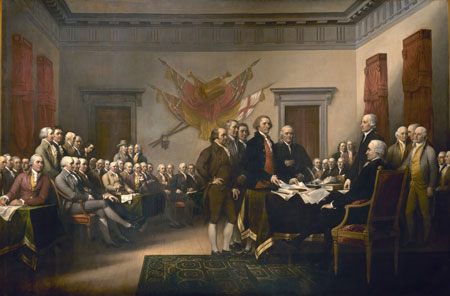
Future President John Adams is standing on the left. The tall gentleman with a red vest is Thomas Jefferson in this famous work by John Trumbull. (Architect of the Capitol)
Wednesday we celebrate the 242nd birthday of the United States of America, the day the Declaration of Independence from Great Britain was signed. Actually, the document was signed on July 2, 1776. (President John Adams was a stickler for love of Independence Day. He argued the document was signed on the second and that should have been Independence Day.)
What exactly did that document accomplish? It alerted the British Crown that Americans were irate about taxes without representation, having to provide shelter for soldiers in their homes, and other quarrels. Did it ascertain that the American Colonies were no longer a part of the British Empire? No, but it set fire to a rebellion that the colonies finally won with national independence.
The date has been duly celebrated in Boston since 1783. The governor of North Carolina issued a proclamation making his state the first to officially celebrate Independence Day. Other cities and states followed suit. In Philadelphia crowds rang the Liberty Bell until it cracked. Parades, picnics, and long speeches given by prominent men, many of whom were running for political office. Crowds filled parks and courthouse lawns for years. Flags waved, fireworks lit up the night sky, and patriotic music filled the air.
However, Congress was a bit slow in making the Fourth of July a national holiday. Federal employees could and were encouraged to take off the day to celebrate with family and friends, but their pay would be docked for that day. It was not until July 4, 1938 that President Roosevelt signed an order to allow the day a legal, federal holiday.
On July 4, 1884 the Republic of France presented the United States a huge present for the soon to be century of American freedom. It was the Statue of Liberty that took four months to assemble once it arrived in New York. The 151-foot-tall statue was shipped from Paris in hundreds of pieces. President Grover Cleveland formally dedicated the Statue on October 28, 1886, only ten years and almost four months later.
Finally, there is the amazing coincidence of presidential deaths. Thomas Jefferson and John Adams are primarily given credit for writing the Declaration of Independence. The two served in Paris later, trying to gain recognition for the United States from France. They were good friends until a difference of opinion fractured that friendship. In later years they reconciled and their correspondence is an amazing exchange of philosophical ideas. Both men died July 4, 1826. It was the 50th anniversary of the Declaration of Independence.
Five years later, James Monroe died on July 4, 1831 in his New York home. He was the last of the Founding Fathers who set our nation on the right track.
